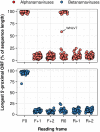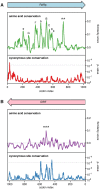A case for a negative-strand coding sequence in a group of positive-sense RNA viruses
- PMID: 32064120
- PMCID: PMC7010960
- DOI: 10.1093/ve/veaa007
A case for a negative-strand coding sequence in a group of positive-sense RNA viruses
Abstract
Positive-sense single-stranded RNA viruses form the largest and most diverse group of eukaryote-infecting viruses. Their genomes comprise one or more segments of coding-sense RNA that function directly as messenger RNAs upon release into the cytoplasm of infected cells. Positive-sense RNA viruses are generally accepted to encode proteins solely on the positive strand. However, we previously identified a surprisingly long (∼1,000-codon) open reading frame (ORF) on the negative strand of some members of the family Narnaviridae which, together with RNA bacteriophages of the family Leviviridae, form a sister group to all other positive-sense RNA viruses. Here, we completed the genomes of three mosquito-associated narnaviruses, all of which have the long reverse-frame ORF. We systematically identified narnaviral sequences in public data sets from a wide range of sources, including arthropod, fungal, and plant transcriptomic data sets. Long reverse-frame ORFs are widespread in one clade of narnaviruses, where they frequently occupy >95 per cent of the genome. The reverse-frame ORFs correspond to a specific avoidance of CUA, UUA, and UCA codons (i.e. stop codon reverse complements) in the forward-frame RNA-dependent RNA polymerase ORF. However, absence of these codons cannot be explained by other factors such as inability to decode these codons or GC3 bias. Together with other analyses, we provide the strongest evidence yet of coding capacity on the negative strand of a positive-sense RNA virus. As these ORFs comprise some of the longest known overlapping genes, their study may be of broad relevance to understanding overlapping gene evolution and de novo origin of genes.
Keywords: RNA virus; overlapping genes.
© The Author(s) 2020. Published by Oxford University Press.
Figures







Similar articles
-
An exploration of ambigrammatic sequences in narnaviruses.Sci Rep. 2019 Nov 29;9(1):17982. doi: 10.1038/s41598-019-54181-3. Sci Rep. 2019. PMID: 31784609 Free PMC article.
-
Persistence of Ambigrammatic Narnaviruses Requires Translation of the Reverse Open Reading Frame.J Virol. 2021 Jun 10;95(13):e0010921. doi: 10.1128/JVI.00109-21. Epub 2021 Jun 10. J Virol. 2021. PMID: 33762418 Free PMC article.
-
Evolutionary relationships among putative RNA-dependent RNA polymerases encoded by a mitochondrial virus-like RNA in the Dutch elm disease fungus, Ophiostoma novo-ulmi, by other viruses and virus-like RNAs and by the Arabidopsis mitochondrial genome.Virology. 1998 Jun 20;246(1):158-69. doi: 10.1006/viro.1998.9178. Virology. 1998. PMID: 9657003
-
Evolution and taxonomy of positive-strand RNA viruses: implications of comparative analysis of amino acid sequences.Crit Rev Biochem Mol Biol. 1993;28(5):375-430. doi: 10.3109/10409239309078440. Crit Rev Biochem Mol Biol. 1993. PMID: 8269709 Review.
-
Origin, Evolution and Stability of Overlapping Genes in Viruses: A Systematic Review.Genes (Basel). 2021 May 26;12(6):809. doi: 10.3390/genes12060809. Genes (Basel). 2021. PMID: 34073395 Free PMC article.
Cited by
-
An exploration of ambigrammatic sequences in narnaviruses.Sci Rep. 2019 Nov 29;9(1):17982. doi: 10.1038/s41598-019-54181-3. Sci Rep. 2019. PMID: 31784609 Free PMC article.
-
Unheeded SARS-CoV-2 proteins? A deep look into negative-sense RNA.Brief Bioinform. 2022 May 13;23(3):bbac045. doi: 10.1093/bib/bbac045. Brief Bioinform. 2022. PMID: 35229157 Free PMC article.
-
Discovery and Community Dynamics of Novel ssRNA Mycoviruses in the Conifer Pathogen Heterobasidion parviporum.Front Microbiol. 2021 Nov 24;12:770787. doi: 10.3389/fmicb.2021.770787. eCollection 2021. Front Microbiol. 2021. PMID: 34899655 Free PMC article.
-
Complete genome of Aedes japonicus narnavirus from wild caught mosquitoes collected in Ohio, USA.MicroPubl Biol. 2023 Sep 5;2023:10.17912/micropub.biology.000909. doi: 10.17912/micropub.biology.000909. eCollection 2023. MicroPubl Biol. 2023. PMID: 37736247 Free PMC article.
-
Polymorphism of genetic ambigrams.Virus Evol. 2021 Apr 19;7(1):veab038. doi: 10.1093/ve/veab038. eCollection 2021 Jan. Virus Evol. 2021. PMID: 34055388 Free PMC article.
References
Grants and funding
LinkOut - more resources
Full Text Sources
Research Materials

